

Education4betterhealth. Cindy Carson, National Director Communication: We’ve been talking a lot lately about communication here at Milner-Fenwick.
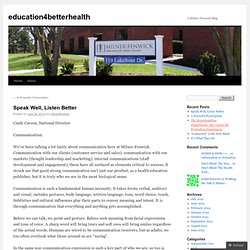
Communication with our clients (customer service and sales); communication with our markets (thought leadership and marketing); internal communications (staff development and engagement), these have all surfaced as elements critical to success. It struck me that good strong communication isn’t just our product, as a health education publisher, but it is truly who we are in the most biological sense. Communication is such a fundamental human necessity. Before we can talk, we point and gesture. In the same way communication expression is such a key part of who we are, so too is listening – especially in healthcare. At Milner-Fenwick, we look at providing quality patient education as a means of engagement, of empowerment, but so too must we as care providers truly listen to patients, we must ourselves be engaging by being present.
Like this: Like Loading... Create a Patient-Centered Culture. Zappos delivers great customer service, but its leader seems to talk mostly about his corporate culture.
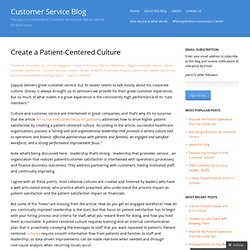
Disney is always brought up in seminars we provide for their great customer experience, but so much of what makes it a great experience is the consistently high performance of its “cast members.” Culture and customer service are intertwined in great companies, and that’s why it’s no surprise that the article NY nurse executives focus on positivity addresses how to drive higher patient satisfaction by creating a patient-centered culture. Program for Readability In Science & Medicine (PRISM)
Program for Readability In Science & Medicine (PRISM) is a Group Health Research Institute initiative to improve the readability of consent forms and other print materials for health care research study participants.
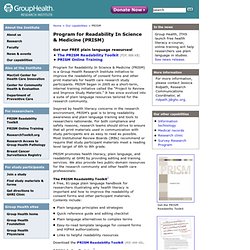
PRISM began in 2005 as a short-term, internal training initiative called the “Project to Review and Improve Study Materials.” It has since evolved into a suite of plain language resources tailored for the research community. Inspired by health literacy concerns in the research environment, PRISM’s goal is to bring readability awareness and plain language training and tools to researchers nationwide.
For both compliance and safety reasons, research teams should strive to ensure that all print materials used in communication with study participants are as easy to read as possible. Most Institutional Review Boards (IRBs) recommend or require that study participant materials meet a reading level target of 6th to 8th grade. Download the PRISM Readability Toolkit (PDF, 888 KB). The Google Approach: How Hospitals Can Create Cultures That Drive Employee Engagement, Satisfaction.
Industry experts say a deliberate, data-driven approach to employee engagement and satisfactions benefits hospitals, their staff members and their patients.
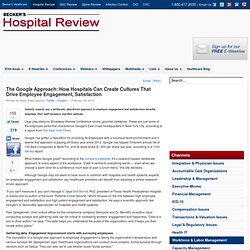
Lego play stations, Broadway-themed conference rooms, gourmet cafeterias. These are just some of the employee perks that characterize Google's East Coast headquarters in New York City, according to a report from The New York Times. Google has gotten a reputation for providing its employees with a luxurious work environment, and it seems that approach is paying off. Every year since 2012, Google has topped Fortune's annual list of 100 Best Companies to Work For, and its stock broke $1,000 per share last year, according to a CNN Money report. What makes Google great? Although Google may not seem to have much in common with hospitals and health systems, experts on employee engagement and satisfaction say healthcare providers can benefit from adopting a similar research-driven approach.
"You want to use the data," he says. Mr. Ms. Best Care at Lower Cost: The Path to Continuously Learning Health Care in America. Report Briefing Slides (PDF) Infographic (PNG, HTML) Press Release (HTML) Recommendations (PDF) Report Brief (PDF, HTML) Sector Briefs (HTML) Table: Characteristics of a Continuously Learning Health Care System (HTML) America's health care system has become far too complex and costly to continue business as usual. Pervasive inefficiencies, an inability to manage a rapidly deepening clinical knowledge base, and a reward system poorly focused on key patient needs, all hinder improvements in the safety and quality of care and threaten the nation's economic stability and global competitiveness. Achieving higher quality care at lower cost will require fundamental commitments to the incentives, culture, and leadership that foster continuous "learning”, as the lessons from research and each care experience are systematically captured, assessed, and translated into reliable care.
Following evidence-based guidelines won't protect you from malpractice. The best way to avoid being sued for malpractice is to make certain that all your patients are happy and all their outcomes are good.
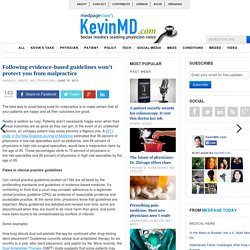
Reality is seldom so rosy. Patients aren’t necessarily happy even when their clinical outcomes are as good as they can get. In the event of an undesired outcome, an unhappy patient may easily become a litigious one. A 2011 study in the New England Journal of Medicine estimated that 36 percent of physicians in low-risk specialties such as pediatrics, and 88 percent of physicians in high-risk surgical specialties, would face a malpractice claim by the age of 45. Those percentages climb to 75 percent of physicians in low-risk specialties and 99 percent of physicians in high-risk specialties by the age of 65. Flaws in clinical practice guidelines Can clinical practice guidelines protect us? Some examples: How long should dual anti-platelet therapy be continued after drug-eluting stent placement?